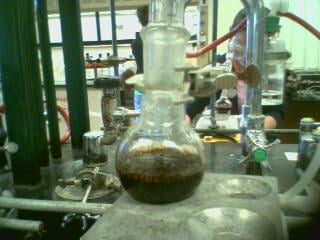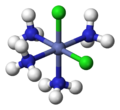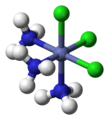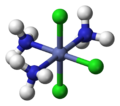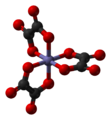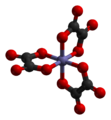Complex (chemistry)
- For other uses of the term, see complex.
A complex in chemistry usually is used to describe molecules or ensembles formed by the combination of ligands and metal ions. Originally, a chemical complex implied a reversible association of molecules, atoms, or ions through weak chemical bonds. As applied to coordination chemistry, this meaning has been modified.
Some metal complexes are formed virtually irreversibly and many are bound together by bonds that are quite strong.
History
Coordination complexes were known, although not understood in any sense, since the beginning of chemistry. Examples include Prussian blue and copper vitriol. The key breakthrough occurred when Alfred Werner proposed, inter alia, that Co(III) bears six ligands in an octahedral geometry. The theory allows one to understand the difference between coordinated and ionic chloride in the cobalt amine chlorides and to explain many of the previously inexplicable isomers. He resolved the first coordination complex into optical isomers, overthrowing the theory that chirality was necessarily associated with carbon compounds.
Metal complexes
Metal complexes, also known as coordination compounds, include all metal compounds, aside from metal vapors, plasmas, and alloys. The study of "coordination chemistry" is the study of "inorganic chemistry" of all alkali and alkaline earth metals, transition metals, lanthanides, actinides, and metalloids. Thus, coordination chemistry is the chemistry of the majority of the periodic table. Metals and metal ions only exist, in the condensed phases at least, surrounded by ligands.
The ions or molecules surrounding the metal are called ligands. Ligands are generally bound to a metal ion by a coordinate covalent bond (donating electrons from a lone electron pair into an empty metal orbital), and are thus said to be coordinated to the ion. The areas of coordination chemistry can be classified according to the nature of the ligands, broadly speaking:
- Classical (or "Werner Complexes"): Ligands in classical coordination chemistry bind to metals, almost exclusively, via their "lone pairs" of electrons residing on the main group atoms of the ligand. Typical ligands are H2O, NH3, Cl−, CN−, en−
- Examples: [Co(EDTA)]−], [Co(NH3)6]Cl3, [Fe(C2O4)3]K3
- Organometallic Chemistry: Ligands are organic (alkenes, alkynes, alkyls) as well as "organic-like" ligands such as phosphines, hydride, and CO.
- Example: (C5H5)Fe(CO)2CH3
- Bioinorganic Chemistry: Ligands are those provided by nature, especially including the side chains of amino acids, and many cofactors such as porphyrins.
- Example: hemoglobin
- Many natural ligands are "classical" especially including water.
- Cluster Chemistry: Ligands are all of the above but also include other metals as ligands.
- Example Ru3(CO)12
- In some cases there are combinations of different fields:
- Example: [Fe4S4(Scysteinyl)4]2−, in which a cluster is embedded in a biologically active species.
Mineralogy, materials science, and solid state chemistry—as they apply to metal ions—are subsets of coordination chemistry in the sense that the metals are surrounded by ligands. In many cases these ligands are oxides or sulfides, but the metals are coordinated nonetheless, and the principles and guidelines discussed below apply. It is true that the focus of mineralogy, materials science, and solid state chemistry differs from the usual focus of coordination or inorganic chemistry. The former are primarily concerned with polymeric structures, properties arising from a collective effects of many highly interconnected metals. In contrast, coordination chemistry focuses on reactivity and properties complexes containing individual metal atoms or small ensembles of metal atoms.
Structure of coordination compounds
Geometry
Structure in complex chemistry begins with a focus on "coordination number," the number of ligands attached to the metal (more specifically, the number of σ-type bonds between ligand(s) and the central atom). Usually one can count the ligands attached but sometimes even the counting can become ambiguous. Coordination numbers are normally between two and nine, but large numbers of ligands are not uncommon. The number of bonds depends on the size, charge, and electron configuration of the metal ion. Most metal ions may have more than one coordination number.
Typically the chemistry of complexes is dominated by interactions between s and p molecular orbitals of the ligands and the d (or f) orbitals of the metal ions. The s, p, and d orbitals of the metal give the possibility to allocate 18 electrons (see 18-Electron rule; for f-block elements this extends to 32 electrons). The maximum coordination number for a certain metal is thus related to the electronic configuration of the metal ion (more specifically, the number of empty orbitals) and to the ratio of the size of the ligands and the metal ion. Large metals and small ligands lead to high coordination numbers, e.g. [Mo(CN)8]4-. Small metals with large ligands lead to low coordination numbers, e.g. Pt[P(CMe3]2. Due to their large size, lanthanides, actinides, and early transition metals tend to have high coordination numbers.
Different ligand structural arrangements result from the coordination number. Most structures follow the points-on-a-sphere pattern (or, as if the central atom were in the middle of a polyhedron where the corners of that shape are the locations of the ligands), where orbital overlap (between ligand and metal orbitals) and ligand-ligand repulsions tend to lead to certain regular geometries. The most observed geometries are listed below, but there are many cases which deviate from a regular geometry, e.g. due to the use of ligands of different types (which results in irregular bond lengths; the coordination atoms do not follow a points-on-a-sphere pattern), due to the size of ligands, or due to electronic effects (see e.g. Jahn-Teller distortion):
- Linear for two-coordination,
- Trigonal planar for three-coordination,
- Tetrahedral or square planar for four-coordination
- Trigonal bipyramidal or square pyramidal for five-coordination,
- Octahedral (orthogonal) or trigonal prismatic for six-coordination,
- Pentagonal bipyramidal for seven-coordination,
- Square antiprismatic for eight-coordination, and
- Tri-capped trigonal prismatic (Triaugmented triangular prism) for nine coordination.
Some exceptions and provisions should be noted:
- The idealized descriptions of 5-, 7-, 8-, and 9- coordination are often indistinct geometrically from alternative structures with slightly different L-M-L (ligand-metal-ligand) angles. The classic example of this is the difference between square pyramidal and trigonal bipyramidal structures.
- Due to special electronic effects such as (second-order) Jahn-Teller stabilization, certain geometries are stabilized relative to the other possibilities, e.g. for some compounds the trigonal prismatic geometry is stabilized relative to octahedral structures for six-coordination.
Isomerism
The arrangement of the ligands is fixed for a given complex, but in some cases it is mutable by a reaction that forms another stable isomer.
There exists many kinds types of isomerism in coordination complexes, just as in many other compounds.
Stereoisomerism
Stereoisomerism occurs with the same bonds in different orientations relative to one another. Stereoisomerism can be further classified into:
Geometric isomerism
Geometric isomerism occurs in octahedral and square planar complexes (but not tetrahedral). When two ligands are opposite each other they are said to be trans, when mutually adjacent, cis. When three identical ligands occupy one face of an octahedron, the isomer is said to be facial, or fac. If these three ligands are coplanar, the isomer is said to be meridional, or mer. For example, in an octahedral compound with three of one ligand and three of another, there are two geometric isomers: the mer in which each set of three same ligands is in a meridian and the fac in which each set of three is on a face of the octahedron.
Optical isomerism
Optical isomerism occurs when the mirror image of a compound is not superimposable with the original compound. It is so called because such isomers are optically active, that is, they rotate the plane of polarized light. The symbol Λ (delta) is used as a prefix to describe the left-handed propeller twist formed by three bidentate ligands, as shown. Similarly, the symbol Δ (lambda) is used as a prefix for the right-handed propeller twist.
Structural isomerism
Structural isomerism occurs when the bonds are themselves different. Linkage isomerism is only one of several types of structural isomerism in coordination complexes (as well as other classes of chemical compounds). Linkage isomerism occurs with ambidentate ligands which can bind in more than one place. For example, NO2 is an ambidentate ligand: it can bind to a metal at either the N atom or at an O atom.
Older classifications of isomerism
Traditional classifications of the kinds of isomer have become archaic with the advent of modern structural chemistry. In the older literature, one encounters:
- Ionisation isomerism describes the possible isomers arising from the exchange between the outer sphere and inner sphere. This classification relies on an archaic classification of the inner and outer sphere. In this classification, the "outer sphere ligands," when ions in solution, may be switched with "inner sphere ligands" to produce an isomer.
- Solvate isomerism occurs when an inner sphere ligand is replaced by a solvent molecule. This classification is obsolete because it considers solvents as being distinct from other ligands. Some of the problems are discussed under water of crystallization.
Electronic structure of coordination compounds
Many of the properties of metal complexes are dictated by their electronic structures. The electronic structure can be described by a relatively ionic model that ascribes formal charges to the metals and ligands and does not focus on covalency. This approach is the essence of Crystal field theory (CFT). Crystal field theory, introduced by Hans Bethe in 1929, gives a quantum mechanically based attempt at understanding complexes. But crystal field theory treats all interactions in a complex as ionic and assumes that the ligands can be approximated by negative point charges.
More sophisticated models embrace covalency, and this approach is described by Ligand field theory (LFT) and Molecular orbital theory (MO). Ligand field theory, introduced in 1935 and built from molecular orbital theory, can handle a broader range of complexes and can explain complexes in which the interactions are covalent. The chemical applications of group theory can aid in the understanding of crystal or ligand field theory, by allowing simple, symmetry based solutions to the formal equations.
Chemists tend to employ the simplest model required to predict the properties of interest; for this reason, CFT has been a favorite for the discussions when possible. MO and LF theories are more complicated, but provide a more realistic perspective.
The electronic configuration of the complexes gives them some important properties:
Color
Metal complexes often have spectacular colors. These colors arise from the absorption of light which excites electrons within the metal's orbitals or, in the case of charge-transfer, excites electrons from metal-based orbitals to ligand-based orbitals (or the reverse). An aid to explain and interpret electronic excitations within the collection of metal-based orbitals are the Tanabe-Sugano diagrams (for simple compounds with a good defined geometry) or the use of computational chemistry.
Magnetism
Metal complexes that have unpaired electrons are magnetic. Considering only monometallic complexes, unpaired electrons arise because the complex has an odd number of electrons or because electron pairing is destabilized. Thus, monomeric Ti(III) species have one "d-electron" and must be (para)magnetic, regardless of the geometry or the nature of the ligands. Ti(II), with two d-electrons, forms some complexes that have two unpaired electrons and others with none. This effect is illustrated by the compounds TiX2[(CH3)2PCH2CH2P(CH3)2]2: when X = Cl, the complex is paramagnetic (high spin configuration) whereas when X=CH3, it is diamagnetic (low spin configuration). It is important to realize that ligands provide an important means of adjusting the ground state properties.
In bi- and polymetallic complexes, in which the individual centers have an odd number of electrons or which are high spin, the situation is more complicated. If there is interaction (either direct or through ligand) between the two (or more) metal centers, the electrons may couple (antiferromagnetic coupling, resulting in a diamagnetic compound), or they may enhance each other (ferromagnetic coupling). When there is no interaction, the two (or more) individual metal centers behave as if in two separate molecules.
Reactivity
Complexes show a variety of possible reactivities:
- Electron transfers
- A common reaction between coordination complexes involving ligands are inner and outer sphere electron transfers. They are two different mechanisms of electron transfer redox reactions, largely defined by the late Henry Taube. In an inner sphere reaction, a ligand with two lone electron pairs acts as a bridging ligand, a ligand to which both coordination centres can bond. Through this, electrons are transferred from one centre to another.
- (Degenerate) ligand exchange
- One important indicator of reactivity is the rate of degenerate exchange of ligands. For example, the rate of interchange of coordinate water in [M(H2O)6]n+ complexes varies over 20 orders of magnitude. Complexes where the ligands are released and rebound rapidly are classified as labile. Such labile complexes can be quite stable thermodyanically. Typical labile metal complexes have either low charge (Na+), electrons in d-orbitals that are antibonding with respect to the ligands (Zn2+), or lack covalency (Ln3+, where Ln is any lanthanide). The lability of a metal complex also depends on the high vs. low spin configurations when such is possible. Thus high spin Fe(II) and Co(III) form labile complexes whereas low spin analogues are inert. Cr(III) can only exist in the low-spin state (quartet), which is inert because of its high formal oxidation state, absence of electrons in orbitals that are M-L antibonding, plus some "ligand field stabilization" associated with the d3 configuration.
- Associative processes
- Complexes that have unfilled or half-filled orbitals often show the capability to react with substrates. Most substrates have a singlet ground-state , that is, they have lone electron pairs (e.g. water, amines, ethers), so these substrates need an empty orbital to be able to react with a metal centre. Some substrates (e.g. molecular oxygen!) have a triplet ground state, which results that metals with half-filled orbitals have a tendency to react with such substrates (it must be said that the dioxygen-molecule also has lone pairs, so it is also capable to react as a 'normal' Lewis base).
If the ligands around the metal are carefully chosen, the metal can aid in (stoichiometric or catalytic) transformations of molecules or be used as a sensor.
Naming complexes
The basic procedure for naming a complex:
- When naming a complex ion, the ligands are named before the metal ion.
- Write the names of the ligands in alphabetical order. (Numerical prefixes do not affect the order.)
- Multiply occurring monodentate ligands receive a prefix according to the number of occurrences: di-, tri-, tetra-, penta-, or hexa. Polydentate ligands (e.g., ethylenediamine, oxalate) receive bis-, tris-, tetrakis-, etc.
- Anions end in o. This replaces the final 'e' when the anion ends with '-ate', e.g. sulfate becomes sulfato. It replaces 'ide': cyanide becomes cyano.
- Neutral ligands are given their usual name, with some exceptions: NH3 becomes ammine; H2O becomes aqua or aquo; CO becomes carbonyl; NO becomes nitrosyl.
- Write the name of the central atom/ion. If the complex is an anion, the central atom's name will end in -ate, and its Latin name will be used if available (except for mercury).
- If the central atom's oxidation state needs to be specified (when it is one of several possible, or zero), write it as a Roman numeral (or 0) in parentheses.
- Name cation then anion as separate words (if applicable, as in last example)
Examples:
- [NiCl4]2− → tetrachloronickelate(II) ion
- [CuNH3Cl5]3− → amminepentachlorocuprate(II) ion
- [Cd(en)2(CN)2] → dicyanobis(ethylenediamine)cadmium(II)
- [Co(NH3)5Cl]SO4 → pentaamminechlorocobalt(III) sulfate
The coordination number of ligands attached to more than one metal (bridging ligands) is indicated by a subscript to the Greek symbol μ placed before the ligand name. Thus the dimer of aluminium trichloride is described by Al2Cl4(μ2-Cl)2.
See also
ReferencesISBN links support NWE through referral fees
- De Vito, D., J. Weber, A.E. Merbach. 2005. Calculated Volume and Energy Profiles for Water Exchange on t2g 6 Rhodium(III) and Iridium(III) Hexaaquaions: Conclusive Evidence for an Ia Mechanism," Inorganic Chemistry. 43:858-863.
- Naming Coordination Compounds. Washington University in St. Louis. Retrieved November 8, 2007
- Zumdahl, Steven S. 2005. Chemical Principles. New York, NY: Houghton Mifflin. ISBN 0618372067.
External links
All links retrieved January 7, 2024.
| ||||||||
Credits
New World Encyclopedia writers and editors rewrote and completed the Wikipedia article in accordance with New World Encyclopedia standards. This article abides by terms of the Creative Commons CC-by-sa 3.0 License (CC-by-sa), which may be used and disseminated with proper attribution. Credit is due under the terms of this license that can reference both the New World Encyclopedia contributors and the selfless volunteer contributors of the Wikimedia Foundation. To cite this article click here for a list of acceptable citing formats.The history of earlier contributions by wikipedians is accessible to researchers here:
The history of this article since it was imported to New World Encyclopedia:
Note: Some restrictions may apply to use of individual images which are separately licensed.
